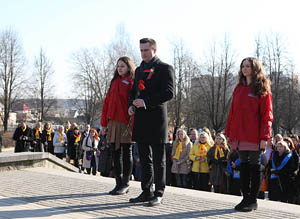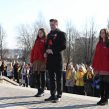
Belarus’s Economic Crisis and National Unity
Publication: Eurasia Daily Monitor Volume: 12 Issue: 60
By:

At present, news coming out of Belarus is marked by two particular refrains: the economic crisis and a search for national consolidation. These refrains may be interrelated since negative macroeconomic trends, coupled with a lack of structural reforms that would boost the private sector, make Belarus overly dependent on Russia. And in the absence of a unifying national idea, it would be difficult to resist Russia’s alleged temptation to incorporate Belarus. “The Crimea-like outcome,” writes Yury Drakakhrust of Radio Liberty in his by-weekly column for Tut.by, Belarus’s largest privately owned news and analysis portal, “can be achieved by various means. But their common denominator is weak national unity, whereby a critical mass of people begins to think that their country is in fact Russia.” He concludes, “The ‘polite people’ come next,” alluding to the insignia-less Russian military personnel that ensured last year’s silent annexation of Crimea without a single shot being fired (Tut.by, March 23).
The level of Belarus’s economic dependency on Russia is, indeed, on the rise. Russia’s Prime Minister Dmitry Medvedev has announced that repayment of previously issued Russian loans to Belarus will be extended. Throughout 2014, Belarus received Russian loans worth $2 billion, including a $450 million line of credit directly from the Russian government at 4-percent interest for ten years. The repayment of this loan will now be extended. Currently, servicing international debts is becoming more difficult than before as exports have been declining. Normally, Belarus’s exports account for 70 percent of the country’s GDP, but in January 2015, exports were 22.7 percent lower than in January 2014 (Naviny.by, March 28). Because Russia’s demand for Belarusian industrial products has been dropping, some Belarusian enterprises have had to reduce working hours or furlough workers. For example, MAZ, the major truck-production company, has stopped its assembly line from March 27 to April 6, with workers receiving two-thirds of their regular wages during that period. Moreover, in 2014, MAZ sold 2,238 trucks in Russia—22.7 percent less than in 2013. In January 2015, almost 80,000 people in Belarus worked less than a full week’s working hours. Almost 90 percent of them are in the processing industry (Naviny.by, March 26). Against the backdrop of economic decline, the resumption of appeals by Russian President Vladimir Putin to introduce a common currency in the Eurasian Union (see EDM, March 27) is perceived as potentially dangerous. Because the sheer size of the Belarusian economy is just 3.5 percent that of its Russian counterpart, the monetary policy would be entirely dictated by Russian interests (Tut.by, March 27).
Boosting national unity in the face of economic vulnerabilities, then, appears to be the task of the day. According to Drakakhrust, however, the two major segments of Belarusian society—the Westernizers (at least a quarter of the population) and the pro-government forces—prefer to exchange “ideological mantras” but do not look at the unity/consolidation problem “technologically,” that is in terms of what actually may appeal to the broad masses of Belarusians.
In that sense, it is noteworthy which historical events imbued with national symbolism preoccupy those two segments lately. For the pro-Western opposition, the principal event has been the Day of Liberty march that occurred on March 25, the anniversary of the proclamation of the short-lived Belarusian People’s Republic (March 25–December 3, 1918). This year, a demonstration under white-red-white flags, which used to be the national flags of Belarus from 1992 to 1995, gathered no more than 1,000 people. According to Alexander Klaskovsky, a veteran opposition-minded analyst, the small gathering was due to officials procrastinating on giving official permission for the rally, the weakness of the opposition beset with internecine fights, and the implications of the Ukrainian crisis for the broad masses of Belarusians—i.e., a perceived inadmissibility of large anti-governmental rallies (Naviny.by, March 25).
For the pro-government side, the major event is the upcoming 70th anniversary of the end of the Great Patriotic War—the popular name given to World War II in Russia and Belarus. Specifically, members of the government-sponsored Belarusian Republican Youth Union planted an apple orchard at Trostenets, the site of the largest Nazi concentration camp in Belarus (and the fourth-largest in occupied Europe) where more than 200,000 people perished (Belta, March 24). The war theme has long been central for national consolidation along the lines of official Minsk.
No recent attempts have been made in Belarus to somehow marry or collectively embrace both of these triggers of national memory. Conversely, on the government news agency’s portal, an article appeared making a point that the Belarusian People’s Republic cannot possibly be considered the foundation of Belarusian statehood in view of its lack of recognition both at home and abroad (Belta, March 25). Meanwhile, the opposition did not make any references at all to the theme of the Great Patriotic War or the particular event at Trostenets.
Given these two national narratives, international developments do not seem to boost national consolidation either. In Russia, for example, a semi-official campaign continues to discredit any alleged departures of Belarus from a joint Russian-Belarusian legacy. Thus, the Russian press agency Regnum, which has set the tone for this campaign, criticized an idea expressed by Belarus’s ambassador to Moscow to swap paintings by Russian 19th-century artist Ivan Shishkin displayed in the National Museum of Art in Minsk for a collection showcasing Belarusian “Slutsk Belts” (see EDM, January 21, 2014) that is being held in Russia. As Regnum claims, this element of attire belonged to regional nobilities that embraced Polish, not Belarusian identity (Regnum, March 27).
Meanwhile, on the Western side, rapprochement with Minsk continues. Thus, Latvian President Andris Berzins declared that if Alyaksandr Lukashenka decides to attend the Eastern Partnership meeting to be held in Riga in May, Berzins, will personally invite him for the official meeting (Tut.by, March 27). This marks a stark contrast with the 2009 statement by then-president Vaclav Klaus of the Czech Republic, who announced that he would not shake hands with Lukashenka should he arrive in Prague for the inaugural meeting of the Eastern Partnership (Grigory Ioffe, Reassessing Lukashenka, 2014, p. 92).
In conclusion, Belarus has entered a period of economic crisis while struggling with divergent narratives pertaining to its national memory. Therefore, the task of promoting national consolidation remains topical and urgent for this Eastern European state.




